When we think of Polynesia, we often imagine turquoise waters, volcanic islands, and vibrant traditions. But behind the beauty lies one of the greatest stories of exploration in human history. Long before GPS or modern navigation, Polynesian voyagers charted thousands of miles of open ocean, guided only by the stars, the waves, and the flight of birds. Along with their courage and knowledge of the sea, they carried something else of immense importance: the plants and crops that would sustain new island communities
The Age of the Voyagers
Between 3,000 and 1,000 years ago, Polynesian navigators embarked on epic journeys across the Pacific. Their double-hulled canoes were engineering marvels, capable of holding entire families, animals, food, and water. These voyagers weren’t drifting aimlessly, they practiced a precise and sophisticated science of wayfinding, passing navigational knowledge down through generations.
With each new landfall, Samoa, Tonga, Tahiti, Rapa Nui, Aotearoa (New Zealand), and eventually Hawai‘i, they brought with them the essentials of life: coconuts, bananas, breadfruit, taro, sugarcane, and kava. These “canoe plants” were carefully selected and nurtured to provide food, medicine, and cultural connection in distant islands.
Kava’s Journey Through the Pacific
Among these crops, kava (Piper methysticum) held a unique place. More than just a root, it carried deep cultural meaning. In Tonga and Fiji, kava ceremonies marked diplomacy, celebration, and spiritual connection. In Samoa, it was a cornerstone of community gatherings.
When Polynesian voyagers arrived in Hawai‘i around 1,000 years ago, they brought kava, known locally as ʻawa. It quickly became part of Hawaiian daily life and ceremony. High chiefs and priests used ʻawa in religious rituals, while farmers and fishermen drank it for relaxation after long days of work. Like elsewhere in Polynesia, it wasn’t simply a drink, it was a way of weaving people together, fostering respect, unity, and calm.
Hawai‘i’s Canoe Plant Legacy
Today, many of the plants that Polynesian voyagers carried are still central to Hawaiian culture and agriculture. Taro remains the heart of poi, a staple food. Breadfruit orchards grow across the islands. Coconut palms line the beaches. And kava, though less widespread than in ancient times, remains a living reminder of this shared heritage.
The story of these crops is really the story of survival, ingenuity, and connection. They tell us that Hawai‘i’s abundance didn’t happen by chance, it was carefully carried across thousands of miles of ocean by people who knew exactly what they were doing.
Keeping the Spirit of Exploration Alive
That spirit of exploration still echoes today. Just as Polynesian voyagers once shared the gifts of their islands across the Pacific, we now share those same flavors in new ways. Taha Kava is a continuation of that story — a modern expression of an ancient tradition.
Instead of voyaging canoes, our kava travels in 12-oz cans. Instead of ceremonial bowls, friends gather with a chilled drink in hand. The setting may have changed, but the essence is the same: connection, relaxation, and the timeless flavors of Polynesia.
So next time you open a can of Taha, take a moment to remember the great voyages that brought kava to Hawai‘i, and the spirit of discovery that keeps guiding us forward.

